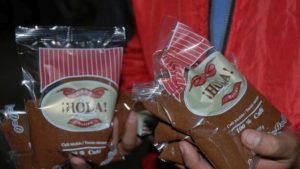 CUBA POR DENTRO: “DESAPARECE” EN CUBA EL CAFE DEL MERCADO DE LA ISLA.
CUBA POR DENTRO: “DESAPARECE” EN CUBA EL CAFE DEL MERCADO DE LA ISLA.
El café, uno de los productos más emblemáticos de Cuba, vuelve a ausentarse de los mercados de la Isla debido a problemas en la producción ocasionados por “el arribo tardío del envase”, según ha reportado la prensa oficial en respuesta a las quejas de los consumidores.
Desde hace semanas los clientes han reportado el desabastecimiento del producto en los mercados en moneda nacional y en pesos convertibles.
La falta de café ha provocado un amplio malestar en una población altamente consumidora de esta infusión, pero también entre quienes tienen cafeterías, restaurantes y hostales dedicados al turismo.
“Estoy pagando más de 15 CUC por un kilogramo de café porque en algunas tiendas solo quedan los paquetes más grandes, esos que tiene menos salida”, cuenta a 14ymedio una emprendedora que gestiona cuatro habitaciones para turistas a pocos metros de la Plaza de San Francisco, en La Habana. “La otra opción es comprar en el mercado negro el café que viene de Miami”, agrega.
Con un amplio surtido, el mercado informal de la Isla ofrece paquetes de las marcas La Llave, Bustelo y Pilón. Los sobres de un poco más de 280 gramos cuestan alrededor de 8 CUC en ese mercado, el salario de toda una semana de un profesional cubano. “A mí me da negocio porque mis clientes pagan en pesos convertibles, pero tengo vecinas que no toman café hace más de una semana”, explica la cuentapropista.
El café es uno de los productos que todavía se distribuye a través de la red de bodegas que el Estado mantiene para vender alimentos racionados y subsidiados, conocidos en Cuba como “la cuota”. Aunque al inicio de su comercialización costaba centavos, en la actualidad el paquete de café de unas 7 onzas -del que cada cubano solo puede comprar uno al mes- cuesta 4 pesos cubanos.
El café se vende mezclado con un 50% de otros granos, especialmente chícharos, porque según dijo el entonces gobernante, Raúl Castro, Cuba no se podía “dar el lujo” de gastar 50 millones de dólares en adquirir en el mercado internacional el café que no produce.
El mercado informal de la Isla también se abastece del café que los empleados roban en las bodegas, en las torrefactoras y en los campos estatales. Un vendedor ilegal de café dijo a 14ymedio que esta semana se vio obligado a usar bolsas de nylon para envolver el producto. “No puedo dejar que se me caiga el negocio. Si no hay bolsas regulares lo vendo a granel”, dijo. El precio de una bolsa de café mezclado en el mercado informal ronda los 3 CUC.
A inicios de este año las autoridades del sector anunciaron que esperaban producir 9.000 toneladas de café, como parte de un plan de recuperación del sector, severamente dañado por el paso del huracán Sandy en 2012 y los problemas que por décadas han padecido las áreas forestales donde se siembra el grano.
La cifra fue anunciada por el director de café, cacao y coco del Grupo Empresarial Agroforestal (GAF) Elexis Legrá, pero con el paso de los meses no ha sido confirmado que se vaya a cumplir para el cierre de 2019. El país importa anualmente cerca de 8.000 toneladas de café desde Vietnam y el resto de otros países de la zona para poder satisfacer una demanda que se calcula en unas 24.000 toneladas al año.
El artista César Leal fue uno de los que dio la alarma en las redes sociales. En su cuenta de Facebook, el pintor escribió que “como suele ocurrir cíclica e inesperadamente en La Habana, y creo que en el resto de Cuba, el café está de nuevo desaparecido de los mercados y tiendas estatales, y hasta del mercado negro”.
Leal cuestionó “¿cómo el llamado ‘bloqueo’ ha influido en la producción de éste, si es un producto nacional, que históricamente sólo ha necesitado de manos cubanas que lo cultiven y cuiden para lograrlo comercializar? ¿También necesitamos la colaboración de los EE UU para incrementar nuestra producción de café? Ello significaría la admisión de que El Enemigo es necesario”, ironizó.
Por su parte, desde Miami algunas familias han comenzado a enviar más café para paliar la escasez en la Isla.
“Tuve que mandar dos paquetes grandes de café La Llave para Cuba porque aquello está en candela. No hay café ni en las tiendas”, dice Yesenia Cortinas, una cubana que reside en Hialeah.
Cortinas dice que su abuela, de 93 años “no puede vivir” sin una taza de café en las mañanas.
“Mi abuela es lo único que me queda en Cuba. Uno aquí hace mil sacrificios para mandarles lo poquito que puede. Ahora es café, pero así mismo he hecho con jabones, pasta, harina… hasta los culeros desechables se los tengo que mandar yo”, lamenta.
 INSIDE CUBA:”DISAPPEARS” IN CUBA COFFEE IN THE MARKET OF THE ISLAND.
INSIDE CUBA:”DISAPPEARS” IN CUBA COFFEE IN THE MARKET OF THE ISLAND.
Coffee, one of the most emblematic products of Cuba, is again absent from the markets of the Island due to production problems caused by “the late arrival of the container”, as reported by the official press in response to complaints from the consumers.
For weeks, customers have reported the shortage of the product in the markets in national currency and in convertible pesos.
The lack of coffee has caused widespread discomfort in a highly consuming population of this infusion, but also among those who have cafes, restaurants and hostels dedicated to tourism.
“I am paying more than 15 CUC for a kilogram of coffee because in some stores there are only the largest packages, those that have less output,” says an entrepreneur who manages four rooms for tourists a few meters from the Plaza de San Francisco, In the Habana. “The other option is to buy coffee from Miami on the black market,” he adds.
With a wide assortment, the informal market of the Island offers packages of the brands La Llave, Bustelo and Pilón. Envelopes of just over 280 grams cost about 8 CUC in that market, the salary of a whole week of a Cuban professional. “It gives me business because my clients pay in convertible pesos, but I have neighbors who don’t drink coffee for more than a week,” explains the self-employed account.
Coffee is one of the products that is still distributed through the network of wineries that the State maintains to sell rationed and subsidized food, known in Cuba as “the quota”. Although at the beginning of its commercialization it cost pennies, at present the coffee package of about 7 ounces – of which each Cuban can only buy one per month – costs 4 Cuban pesos.
The coffee is sold mixed with 50% of other grains, especially peas, because according to the then ruler, Raúl Castro, Cuba could not “afford” to spend 50 million dollars to acquire in the international market the coffee that it does not produce.
The informal market of the Island also supplies the coffee that employees steal in the warehouses, in the roasters, and in the state fields. An illegal coffee seller told 14ymedio that this week he was forced to use nylon bags to wrap the product. “I can’t let the business drop me. If there are no regular bags I sell it in bulk,” he said. The price of a bag of mixed coffee in the informal market is around 3 CUC.
Earlier this year the authorities of the sector announced that they expected to produce 9,000 tons of coffee, as part of a recovery plan for the sector, severely damaged by the passage of Hurricane Sandy in 2012 and the problems that the forest areas have suffered for decades where the grain is sown.
The figure was announced by the director of coffee, cocoa, and coconut of the Agroforestry Business Group (GAF) Elexis Legrá, but over the months it has not been confirmed that it will be met by the end of 2019. The country imports annually close to 8,000 tons of coffee from Vietnam and the rest of other countries in the area to meet a demand that is estimated at about 24,000 tons per year.
The artist César Leal was one of those who gave the alarm on social networks. In his Facebook account, the painter wrote that “as usually happens cyclically and unexpectedly in Havana, and I think that in the rest of Cuba, coffee is again disappeared from state markets and stores, and even from the black market.”
Leal questioned “how the so-called ‘blockade’ has influenced the production of this if it is a national product, which historically has only needed Cuban hands to cultivate and care to achieve marketing? We also need the collaboration of the United States to increase our coffee production? That would mean the admission that the Enemy is necessary, “he said.
COFFEE FROM MIAMI.
For their part, from Miami, some families have begun to send more coffee to alleviate the shortage on the Island.
“I had to send two large packages of La Llave coffee for Cuba because there “está en candela”. There is no coffee or in stores,” says Yesenia Cortinas, a Cuban who lives in Hialeah.
Cortinas says his 93-year-old grandmother “can’t live” without a cup of coffee in the morning.
“My grandmother is the only thing I have left in Cuba. One here makes a thousand sacrifices to send them as little as possible. Now it is brown, but I have also done soaps, pasta, flour … even the disposable culeros I have to send them to me “, explained.
Agencies/ 14ymedio/ Internet Photos/ Arnoldo Varona/ www.TheCubanHistory.com
THE CUBAN HISTORY, HOLLYWOOD.











